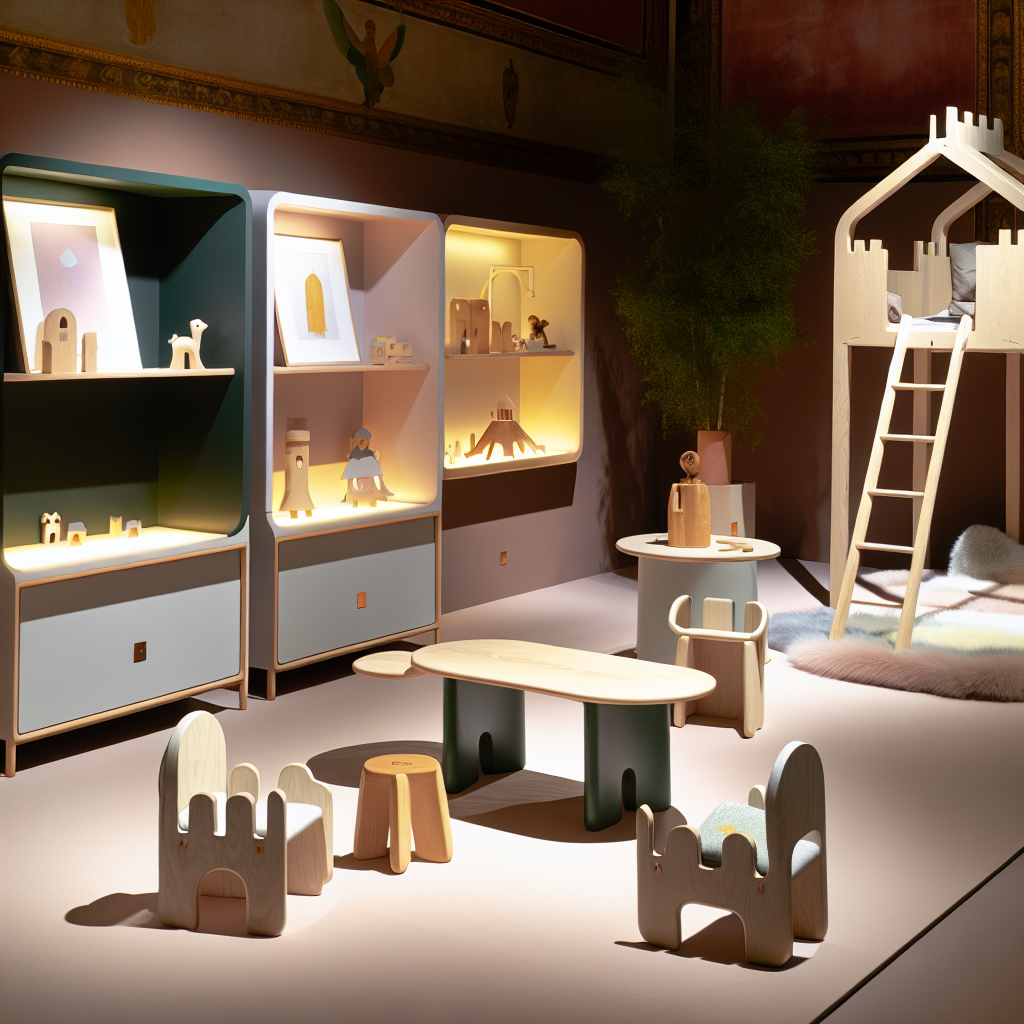Exclusive Designer Kids’ Furniture Collaborations: Limited-Edition Collections Redefining Childhood Interiors
In today’s luxury design world, children’s furniture and interior spaces are no longer an afterthought. The rise of child-focused luxury interiors reflects a deep shift in how affluent families perceive childhood—no longer merely functional but as spaces of inspiration, growth, and sophistication.
At the intersection of art, fashion, and interior design lies a compelling trend: exclusive designer kids’ furniture collaborations. These limited-edition collections combine high fashion with superior functionality, curated for the cultivated tastes of modern elite parents.
From quilted velvet loungers inspired by Chanel runway aesthetics to cribs crafted with the precision of Italian ateliers, every piece tells a story. High-end fashion giants such as Fendi and Gucci, alongside iconic interior brands like Restoration Hardware and Pottery Barn Kids, have made a noteworthy entry into luxury children’s furniture. These collaborations elevate children’s room design to collector-worthy levels, echoing adult interior trends while infusing child-friendly whimsy and imagination.
Limited-edition designer kids’ furniture is thriving not only due to exclusivity but because these pieces hold both artistic merit and investment value. No longer relegated to baby shower wish lists, items such as a Baccarat crystal-accented rocking horse or an Hermès leather toddler chair are now considered essential décor decisions among elite families. Typically launched in small batches or exclusive campaigns, often with endorsements from celebrities or renowned artists, these limited pieces are emblematic of status, discernment, and a purposeful environment for childhood.
Importantly, these collaborations aren’t just about exquisite aesthetics. They prioritize safe materials, sustainable practices, and ergonomic design. This modern synergy of beauty and function appeals to today’s eco-conscious, design-savvy parents who aim to cultivate spaces grounded in style, wellness, and developmental purpose. The result? A bold new standard in childhood interior design, where every ottoman, bookshelf, and pint-sized canopy bed is as intentionally designed as pieces in the master suite.
Designing for Growth: How Well-Curated Spaces Shape Young Minds
The psychology of interior space plays a crucial role in children’s emotional and cognitive development. Research increasingly reveals that well-designed environments for kids can dramatically influence learning, behavior, and emotional regulation.
A 2018 study published in the journal Early Child Development and Care found that visually stimulating, mindfully constructed environments substantially enhance creativity, focus, and emotional regulation in children aged 2 to 7. These findings emphasize the importance of thoughtful interior design—especially as it relates to children’s functional furniture like reading nooks, study tables, and playroom storage solutions.
Complementing this evidence, the American Academy of Pediatrics (AAP) underscores how positive visual and sensory environments help establish strong neural connections and encourage exploration. Furniture that plays with color, soft textures, and dynamic forms has the power to foster sensory integration and improve spatial intelligence. Leading designer furniture collaborations specifically integrate this research into their creation process, prioritizing multi-sensory stimulation in luxurious, child-safe formats.
Ultimately, creating enriching, aesthetically comforting spaces for children feeds directly into their sense of security and inspiration. When kids see their environment as engaging and nurturing, it promotes independence, focus, and emotional well-being.
Sustainable and Safe: The Materials Behind the Marvel
Beyond beauty, the materials used in these furniture collaborations are setting new standards in ethical and wellness-first design. Leading research from the International Living Future Institute highlights the dangers of conventional materials—such as flame retardants, VOCs, and formaldehyde—commonly found in mass-market children’s furnishings.
Instead, brands are now turning to sustainable materials like bamboo, natural latex foam, organic cottons, and untreated solid hardwoods. These materials are not only longer-lasting and environmentally responsible but also safer for sensitive growing bodies.
High-end children’s interior design leaders like Oeuf, Kalon Studios, and Nobodinoz are incorporating artisan-crafted, hypoallergenic, and toxin-free materials into their limited-edition pieces. Many of these brands exceed standard safety regulations, offering furnishings that promote not only eco-conscious living but also respiratory health and allergy reduction.
As a result, these luxury pieces are as much an investment in health and well-being as they are in interior sophistication. Choosing furniture from these collections means creating a home environment that is not only visually stunning but fundamentally safe and sustainable for long-term use.
Function that Follows Form: Ergonomic Furniture that Grows with Your Child
The value of ergonomic design cannot be overstated in children’s furnishings. The Journal of Physiotherapy Research reported in 2020 that ergonomically designed seating and activity furnishings improve spine alignment and posture in children, reducing the risk of back and neck issues.
Designer children’s furniture is often crafted with long-term functionality in mind. Adjustable chairs, height-modifying desks, modular shelves, and convertible cribs are just a few examples of how form meets evolving function. These features not only accommodate growth but also extend the lifecycle of each piece, making them more sustainable and cost-effective in the long run.
Additionally, many of these collections incorporate adaptable design themes—both in function and aesthetics—that age gracefully. Instead of bright cartoon themes that children quickly outgrow, these designs favor modern minimalism or classic charm that matures with a child, blending seamlessly into teen or even guest room spaces down the line.
From a health and investment perspective, integrating ergonomic innovation into furniture selection is a best practice. These designs align with a holistic parenting approach that values both physical wellness and timeless utility.
Conclusion: Chic Meets Child-Centric in a New Age of Interiors
Exclusive designer kids’ furniture collections are transforming how we approach early interior environments. Far from being fleeting darlings of the décor world, they represent a merger of elevated aesthetics, child-specific functionality, health consciousness, and long-term value.
As forward-thinking parents continually seek ways to enhance their children’s daily spaces, this niche will only evolve further—pushing the limits of artistry, sustainability, and scientific innovation in children’s design.
In this bold new era, luxury is no longer just for the grown-ups. The next time you envision your child’s space, consider that your options now include custom leather rockers, sculptural bookcases, and kid-sized plush lounges that are as design-forward as anything in the rest of your home. Beautifully beyond trend, these curated interiors are setting the stage for the next generation of visual thinkers, creators, and tastemakers.
References
- Early Child Development and Care – Visual Stimulation and Creativity Study
- American Academy of Pediatrics – Environmental Influences on Child Growth
- International Living Future Institute – Safe Materials and Sustainability Standards
- Journal of Physiotherapy Research – Ergonomic Pediatric Design
- Oeuf NYC – Modern, Eco-Friendly Children’s Furniture
- Kalon Studios – Natural Design with Ethical Sourcing
- Nobodinoz – Style-First Children’s Furniture
For exclusive highlights, interviews, and previews of upcoming luxury children’s furniture launches, visit KidLuxury.com.

Dominic E. is a passionate filmmaker navigating the exciting intersection of art and science. By day, he delves into the complexities of the human body as a full-time medical writer, meticulously translating intricate medical concepts into accessible and engaging narratives. By night, he explores the boundless realm of cinematic storytelling, crafting narratives that evoke emotion and challenge perspectives. Film Student and Full-time Medical Writer for ContentVendor.com




